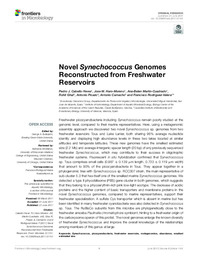Título :
Novel Synechococcus Genomes
Reconstructed from Freshwater
Reservoirs |
Autor :
Cabello Yeves, Pedro J.
DE HARO, JOSE MANUEL 
Martín Cuadrado, Ana Belén
Ghai, Rohit
Picazo, Antonio
Camacho, Antonio
Rodríguez Valera, Francisco |
Departamento:
Departamentos de la UMH::Producción Vegetal y Microbiología |
Fecha de publicación:
2017-06-07 |
URI :
http://hdl.handle.net/11000/4835 |
Resumen :
Freshwater picocyanobacteria including Synechococcus remain poorly studied at the
genomic level, compared to their marine representatives. Here, using a metagenomic
assembly approach we discovered two novel Synechococcus sp. genomes from two
freshwater reservoirs Tous and Lake Lanier, both sharing 96% average nucleotide
identity and displaying high abundance levels in these two lakes located at similar
altitudes and temperate latitudes. These new genomes have the smallest estimated size (2.2 Mb) and average intergenic spacer length (20 bp) of any previously sequenced
freshwater Synechococcus, which may contribute to their success in oligotrophic freshwater systems. Fluorescent in situ hybridization confirmed that Synechococcus sp. Tous comprises small cells (0.987 _ 0.139 mm length, 0.723 _ 0.119 mm width) that amount to 90% of the picocyanobacteria in Tous. They appear together in a phylogenomic tree with Synechococcus sp. RCC307 strain, the main representative of
sub-cluster 5.3 that has itself one of the smallest marine Synechococcus genomes. We detected a type II phycobilisome (PBS) gene cluster in both genomes, which suggests that they belong to a phycoerythrin-rich pink low-light ecotype. The decrease of acidic proteins and the higher content of basic transporters and membrane proteins in the novel Synechococcus genomes, compared to marine representatives, support their freshwater specialization. A sulfate Cys transporter which is absent in marine but has been identified in many freshwater cyanobacteria was also detected in Synechococcus sp. Tous. The RuBisCo subunits from this microbe are phylogenetically close to the freshwater amoeba Paulinella chromatophora symbiont, hinting to a freshwater origin of the carboxysome operon of this protist. The novel genomes enlarge the known diversity of freshwater Synechococcus and improve the overall knowledge of the relationships among members of this genus at large
|
Palabras clave/Materias:
Synechococcus
picocyanobacteria
freshwater reservoirs
metagenomics
abundance
smallest estimated size |
Área de conocimiento :
Microbiología |
Tipo de documento :
info:eu-repo/semantics/article |
Derechos de acceso:
info:eu-repo/semantics/openAccess |
DOI :
https://doi.org/10.3389/fmicb.2017.01151 |
Aparece en las colecciones:
Artículos - Producción vegetal y microbiología
|

 La licencia se describe como: Atribución-NonComercial-NoDerivada 4.0 Internacional.
La licencia se describe como: Atribución-NonComercial-NoDerivada 4.0 Internacional.
.png)